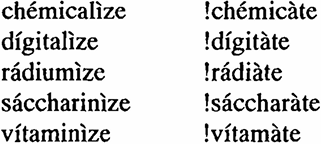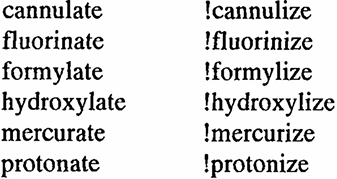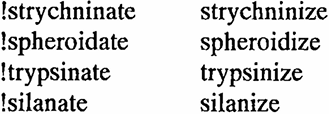


 Grammar
Grammar
 Tenses
Tenses
 Present
Present
 Past
Past
 Future
Future
 Parts Of Speech
Parts Of Speech
 Nouns
Nouns
 Verbs
Verbs
 Adverbs
Adverbs
 Adjectives
Adjectives
 Pronouns
Pronouns
 Pre Position
Pre Position
 Preposition by function
Preposition by function 
 Preposition by construction
Preposition by construction
 Conjunctions
Conjunctions
 Interjections
Interjections
 Grammar Rules
Grammar Rules
 Linguistics
Linguistics
 Semantics
Semantics
 Pragmatics
Pragmatics
 Reading Comprehension
Reading Comprehension|
Read More
Date: 2023-08-12
Date: 2025-02-11
Date: 2023-05-22
|
Rival morphological processes
-ize vs. -ate
Productively formed derivatives in -ate can realize only a small subset of the meanings attested for -ize and -ify derivatives, with an additional se mantic restriction on the potential base words. In van Marie's terms (1985, 1986), -ate could be regarded as the systematic special case in contrast to the more general cases of -ize and -ify. Assuming type-blocking to be operative, one would predict that -ate wins over -ize in its more specific semantic domain, if no other restrictions intervene. As we will shortly see, this prediction is wrong.
Phonologically, the domains of -ize and -ate overlap considerably, making -ate derivatives and -ize derivatives much more similar to each other than to verbs in -ify. Formations involving the former two suffixes have in common that both suffixes take secondary stress, both need an unstressed syllable preceding it, and both may involve the deletion of base-final segments. They differ in those formations in -ate have strictly alternating stress, while -ize may tolerate two preceding adjacent unstressed syllables under the specific conditions. The stress pattern of the two kinds of derivatives may therefore contrast in such a way that -ate formations are always primarily stressed on the antepenult, while -ize verbs may also be stressed on the pre-antepenult. With trochaic bases the suffixes behave similarly.
With these semantic and phonological similarities in mind, let us look at potentially rival formations, i.e. those potential and attested forms that express the ornative-resultative meaning and conform to the semantic restriction on the base words ('chemical substance'). Consider first the derivatives in (1).
(1) 
In the left column of (1) all attested neologisms in -ize are listed that con form to the semantics of -ate verbs and that also feature a stress lapse. Since -ate does not tolerate stress lapses at all (R-ALIGN-HEAD >> MAX C), potential forms in -ate would have to involve the truncation of the base-final rhyme (as in the right column). Although none of the forms in the right column are attested in the OED, they are possible -ate verbs.1
In (2) below I have listed -ate formations where the corresponding -ize word is not attested but seems entirely possible and well-formed, both in semantic and in phonological terms:
(2) 
Crucially, there are also neologims in -ize which are unparalleled by the equally possible -ate formations. Consider the data in (3):
(3) 
Finally, there are also two doublets, given in (4):
(4) 
fluoridize2 ntrógenàte (1927)3
The data in (1) to (4) reveal that type-blocking does not play any role in the distribution of -ize and -ate. Rather, where both suffixes are semantically and phonologically licensed, both can in principle be attached. Sometimes, only one of the two is attested, sometimes the other, sometimes both. Again, the distribution can be accounted for without positing restrictions that go beyond the ones stated already for the individual affixes.
In general, a similar picture emerges here as with -ize and -ify, in that the domains of -ify and -ate do hardly overlap. Since -ate is monosyllabic and subject to almost the same constraint hierarchy as -ize derivatives, the distributional effects are very similar. Recall that -ify prefers iambic bases, -ate trochaic ones, with both types of derivatives needing strictly alternat ing stress. The only systematic overlap is (again) with disyllabic bases ending in an unstressed vowel, which, however, do not surface in the data, since the words denoting chemical substances do either end in other segments, or have more than two syllables. This makes, for example, mercurate (or !mercurize, for that matter) the only possible forms.
In sum, both suffixes may in principle form ornative/resultative verbs on the basis of nouns denoting chemical substances, but the actual domain where -ate and -ize are in competition is extremely small, due to the pertinent phonological restrictions.
|
|
|
|
دخلت غرفة فنسيت ماذا تريد من داخلها.. خبير يفسر الحالة
|
|
|
|
|
|
|
ثورة طبية.. ابتكار أصغر جهاز لتنظيم ضربات القلب في العالم
|
|
|
|
|
|
|
سماحة السيد الصافي يؤكد ضرورة تعريف المجتمعات بأهمية مبادئ أهل البيت (عليهم السلام) في إيجاد حلول للمشاكل الاجتماعية
|
|
|